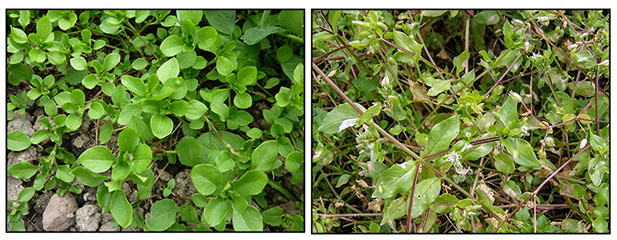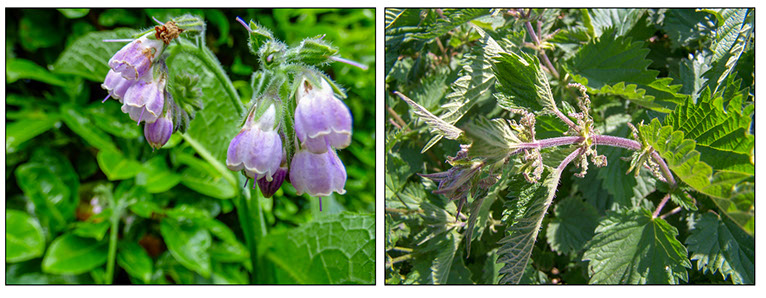

Home
About Us
Allotments
Garden Equipment
Seed Suppliers
Manure Problems
Children's Pages
GLA Blog
Weather Blog
School Veg Patch
Useful Links
Know your weeds
Many of our choice plants, including our vegetable plants, were introduced from other parts of the world or are specially bred. This means that weeds in their natural habitat grow much stronger than the immigrant plants with which they compete for light, space, nutrients and water.
If the more choice plants are to thrive we must give them some help by weeding out the thugs. This is a constant battle as weed seeds can lay dormant in the soil for many years and some will only germinate and flourish once the soil has been cultivated. It is thought that one such plant, chickweed produces seed that can lie dormant in the soil for up to 40 years.

You may have noticed that there tends to be more weeds in our vegetable patches than in the long established perennial borders in our gardens. This is due to the fact that we are less likely to dig the soil around our shrubs and perennials and therefore we do not constantly bring new weed seeds up to the surface. The regular digging of our vegetable patches encourages weed growth. I suppose we could use it as an excuse to never dig again and become a No Dig Gardener.
When a new allotment plot or garden is cleared, the thistles, brambles and docks may be removed, (well eventually anyway), but in so doing we signal that it is growing time for the next phase of weeds.
Today’s choice plants could be tomorrow’s weeds. Japanese knotweed was introduced to this country in the 19 century as an ornamental plant and now is classified as one of our most pernicious weeds. In fact the Wildlife and Countryside act of 1981 states that it is an offence to allow this plant to grow in the wild and there are regulations regarding the disposal of it.
The oil seed rape grown as a crop in our fields is fast becoming a weed in verges. The colourful nasturtiums and English marigolds that one year are grown to provide colour may not be as popular in subsequent years when they have multiplied by a few hundred and are competing with your young cabbage plants.
Weeds like other plants fall into one of three categories.
- Annuals complete their life cycle within a year. Some annual weeds are also classified as ephemeral. Such weeds can grow and set seed in just a few weeks and therefore several generations can be produced during just one year.
- Biennials take two years to grow, flower and set seed.
- Perennials continue to grow year after year. And are among the most difficult type of weeds to get completely rid of. Where possible when weeding, the whole plant, complete with the roots, should be removed.
If possible weeds should be removed before they set seed. The Dutch hoe is one of the best friends of a diligent weeder as it can be used to chop off weed seedlings just below soil level.
Gardeners soon learn to distinguish weed seedlings from the young growth of welcome plants but the web site below may help you decide what to pull up and what to leave growing.
Believe it or not, weeds are not all bad news. Nettles are good activators if popped on the compost heap as is comfrey which could also be classed as a weed! Weeds absorb minerals and nutrients from the soil and therefore by composting them you will return the nourishment to the soil.
You just need to be selective as to which weeds you compost. Don’t compost perennial weeds and also make sure that your compost heap generates high temperatures when rotting. Click here and here for advice on what to compost.
We grow a big clump of comfrey not only for the compost heap but also because the bees absolutely adore it. We have a clump by some of our fruit trees to encourage bees to visit and pollinate the blossom, that is if they can tear themselves away from the comfrey.

A clump of nettles left to grow in a convenient location is also much appreciated by the many butterflies that lay their eggs on them. Don’t worry the white butterflies, that will devastate your cabbages given half a chance, are not one of the nettle loving species.
In the past many plants that we consider to be weeds were grown for their medicinal and healing purposes. In fact many are still being investigated as possible sources for new drugs. For instance the dandelion is reputed to have many medicinal qualities and is being studied as a possible source for a cancer curing drug. Other weeds can be eaten either raw in salad or cooked, however others are poisonous not only to us but to grazing animals too, so if in doubt don’t try eating it!
Below are some of the weeds photographed on our allotment. I've tried to identify them as best I can - if you think any are wrongly identified let me know. I have given just basic names rather than attempting to identify varieties,






































































































Creeping Thistle
Willowherb
Willowherb
Willowherb
Willowherb
Common Hemp Nettle
Common Hemp Nettle
Creeping Cinquefoil
Goosegrass or Cleavers
Goosegrass or Cleavers
Goosegrass or Cleavers
Goosegrass or Cleavers
Goosegrass or Cleavers
Hedge Bindweed
Hedge Bindweed
Hedge Bindweed
Pineapple Weed
Scented Mayweed
Chickweed
Chickweed
Coltsfoot
Coltsfoot
Creeping Buttercup
Creeping Buttercup
Creeping Buttercup
Speedwell
Speedwell
Speedwell
Speedwell
Cranesbill
Dandelion
Dandelion
Dandelion
Dandelion seed head
Dock
Dock
Dock
Fat Hen
Fat Hen
Fat Hen
Groundsel
Groundsel
Groundsel
Groundsel seed heads
Hairy Bittercress
Hairy Bittercress
Hawks Beard
Nipplewort
Spurge
Spurge
Redshank
|<<
<
51 - 51
>
>>|
Our Plot at Green Lane Allotments Blog | A Gardener's Weather Diary | School Vegetable Patch Website
© Our Plot on Green Lane Allotments - Please email me if you wish to use any of this site's content